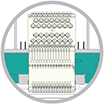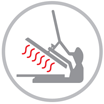


| Front Decoration Dimensions | |||
|---|---|---|---|
| BLP | Bottom Left Pocket | 5"HX5'W | |
| BRP | Bottom Right Pocket | 5"HX5'W | |
| TFP | Top Front Pocket | 7"HX8"W | Primary |
Decoration TechniquesClick the icon for details
Essential Product Information
Due to the nature of 100% polyester fabrics, special care must be taken throughout the decoration process when heat is applied for curing. Please consult with your decorator or material supplier.
Tips From Our Experts By Decoration Technique
Embroidery is the art of embellishing a piece of apparel with a needle and thread or yarn creating stunning visual representations of various types of art. This is achieved by converting logos in a digitizing software and using various stitch patterns, angles, density and stitch types to create depth, movement and detail. Thread can be made from many materials. The most commonly used threads are polyester and rayon. There are also options such as metallic, cotton, nylon, silk and even Nomex thread for fire resistance. Embroidery has a very high-perceived value and is popular for use on most apparel, bags, hats, luggage, blankets and more!
An imprinting method in which the image is transferred to the fabric. Ink is squeegeed through a stenciled screen stretched over a frame and then cured in a dryer.
Low-cure poly inks are required. Grey or black bleed blockers may be necessary.A graphic, name and or number applied to a textile with a heat press. Great for quantities of any size, sports name and numbering, fashion, performance wear, print on demand programs and on-site decorating events.
For best results when using heat applied consumables to avoid a color or sheen change, it is recommended to use a protective foam application pad.
Pad printing uses a soft silicone pad to transfer an image taken from a plate etched with a reversed logo, similar to a rubber stamp. Images can be very small and detailed and can be up to 5½ inches in diameter. Pad printers are capable of printing up to six colors, however most industry printers use one to two colors at most when printing on apparel. Pad printing is a popular trend for tagless label printing. The prints are soft, durable and capable of high and low volume production. Pad printing is great for sling bags, totes and other items that are difficult to decorate, as well as styles that are heat sensitive.
specialty frames and applications that are specific to a shop's setup and equipment.



